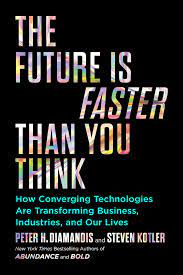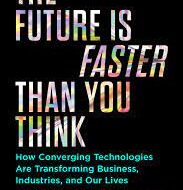Abundance proponent Peter Diamandis brings us another volume – The Future is Faster Than You Think in his exponential trilogy. I find the works interesting and useful and have grouped them under a Tech-Led Abundance image of the future. [I have positioned it as an After Capitalism image, but I’m not sure he would agree with that.]
Pop quiz: What’s the most likely way to get people to pay attention to the future?
A. Wow them with gee-whiz tech that will change the world
B. Present a carefully balanced argument with multiple scenarios and pros and cons
Diamandis has clearly figured out that A is the way to go. While I find the gee-whiz tech stuff a bit off-putting, I can handle it. I thought his arguments in 2012 Abundance were compelling enough to use the concept as one of my three images of After Capitalism. I’m not an anti-tech person. But.. (you knew that was coming), The Future is Faster Than You Think ends with a section on “which way next” that is essentially a commercial for all the various enterprises the author is involved with. I can see how if one really believes in the work one is doing, this may seem to be a logical recommendation. Personally I found it a little cringey. I suppose different readers will net out in different places on that.
Shifting the focus back to our true purpose here on the speed of change. There is no doubt from the get-go and throughout that the argument that change is speeding up and the future is getting here faster. It’s the title of the book and it is the core message. Readers of this blog will probably note my questioning of this argument: Change is slower than we think or confusing movement with progress or the curse of the futurist. The core of my counter-argument is that when we do our proper foresight homework and scanning, we see that this supposedly, fast, rapid, blitzkrieg, out-of-nowhere, unprecedented, VUCA, post-normal change is old news.
Let’s look at some of the quotes in the book. There is some balance in Diamandis’s arguments, if you dig a little bit, but the balanced stuff gets lost in the hyperbole. For instance, he talks about the 6 D’s of exponentials, which includes a deceptive phase in which “early progress is slow” and “these technologies spend a long time failing to live up to the hype.” For instance, VR entered a two-decade deceptive phase in the 1990s after the initial hype wore off. He notes that 3D printing “took a while to get here….it showed up back in the 1980s.”
We are teaching our students and clients to identify these early weak signals, and keep watching them, so that if or when they do gain strength, we’re on top of it – we’re not surprised. In research we’re doing about how domains (topic areas) develop over time, we’re finding that they tend to be developing slower than we thought. We looked at Molitor’s classic research on emerging issues and noted he talked about an average of more than 30 years from weak signal to fruition. The future only seems to be faster if we are not paying attention. And it’s our job as futurists to pay attention! – Andy Hines


Thoughtful and well-argued. Thank you, Andy.
My view is that the future is both fast and slow. The “great acceleration” graphs provide some evidence of the accelerating pace of change for a set of socio-economic and bio-physical indicators: https://www.anthropocene.info/great-acceleration.php
dave
Fair enough. My “slower” take on the Great Acceleration would be that this is happening over a very long period of time, thus if we are paying attention (i.e. horizon scanning) we should not be surprised by it. I know you’re not being surprised!